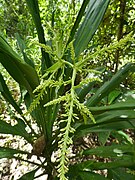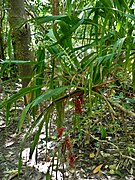Cordyline manners-suttoniae
| Giant Palm Lily | |
|---|---|

| |
| In fruit, in the Cairns Botanic Gardens precinct, April 2024 | |
| Scientific classification | |
| Kingdom: | Plantae |
| Clade: | Tracheophytes |
| Clade: | Angiosperms |
| Clade: | Monocots |
| Order: | Asparagales |
| Family: | Asparagaceae |
| Subfamily: | Lomandroideae |
| Genus: | Cordyline |
| Species: | C. manners-suttoniae
|
| Binomial name | |
| Cordyline manners-suttoniae | |
| Synonyms[2][3] | |
|
Cordyline terminalis var. manners-suttoniae (F.Muell.) Baker | |
Cordyline manners-suttoniae, commonly known as the giant palm lily, is an evergreen plant found only in rainforest of northeastern Queensland, Australia.[1][4]
Description
[edit]Cordyline manners-suttoniae is an erect shrub growing to about 4 or 5 m (13 or 16 ft) tall, and may be single stemmed or branched. The large simple leaves are crowded at the ends of the branches. They may reach 65 cm (26 in) long and 12 cm (4.7 in) wide, and are arranged spirally around the stem. Lateral veins run more or less parallel to each other with numerous secondary veins between them. The fleshy petiole may be 30 cm (12 in) long, is "U" shaped in cross-section, and the base widens into a sheath clasping the stem.[4][5][6]
The inflorescences are panicles measuring up to 25 cm (9.8 in) long, produced either terminally or from the leaf axils. The bisexual flowers are about 12 mm (0.47 in) long with 3 white or cream petals; they are held on pedicels about 10 mm (0.39 in) long. There are six stamens, the ovary is 3-lobed with 2-16 ovules per locule. The fruit is a bright red glossy berry (in botanical terms) measuring about 8–15 mm (0.31–0.59 in) diameter, containing up to eight small black seeds.[4][5][6][7]
Taxonomy
[edit]This species was first described by the German-Australian botanist Ferdinand von Mueller, who published the name and description in his book Fragmenta phytographiæ Australiæ in 1866.[8]
Etymology
[edit]The genus name Cordyline is from the Greek kordyle meaning "club", a reference to the swollen roots of some species.[5][6] The species epithet manners-suttoniae was given by Mueller in honour of the wife of the Victorian Governor John Henry Manners-Sutton.[8]
Distribution and habitat
[edit]The giant palm lily is found in eastern Queensland from about Cooktown southwards to about Rockhampton. It inhabits rainforest in very wet areas, near swamps and areas with poorly drained soils. The altitudinal range is from near sea level to about 700 m (2,300 ft).[4][5][6]
Ecology
[edit]The fruit of this species are eaten by birds, including the figbird (Sphecotheres vieilloti).[6]
Gallery
[edit]-
Habit
-
Immature inflorescence
-
Flowers
-
Fruit
-
With both flowers and fruit
References
[edit]- ^ a b "Species profile—Cordyline manners-suttoniae". Queensland Department of Environment and Science. Queensland Government. 2022. Retrieved 1 May 2024.
- ^ a b "Cordyline manners-suttoniae". Australian Plant Name Index (APNI). Centre for Australian National Biodiversity Research, Australian Government. Retrieved 1 May 2024.
- ^ a b "Cordyline manners-suttoniae F.Muell". Plants of the World Online. Royal Botanic Gardens, Kew. 2024. Retrieved 1 May 2024.
- ^ a b c d F.A.Zich; B.P.M.Hyland; T.Whiffen; R.A.Kerrigan (2020). "Cordyline manners-suttoniae". Australian Tropical Rainforest Plants Edition 8 (RFK8). Centre for Australian National Biodiversity Research (CANBR), Australian Government. Retrieved 1 May 2024.
- ^ a b c d Pedley, L. (2022). "Cordyline manners-suttoniae". Flora of Australia. Australian Biological Resources Study, Department of Climate Change, Energy, the Environment and Water: Canberra. Retrieved 1 May 2024.
- ^ a b c d e Cooper, Wendy; Cooper, William T. (June 2004). Fruits of the Australian Tropical Rainforest. Clifton Hill, Victoria, Australia: Nokomis Editions. p. 152. ISBN 978-0958174213.
- ^ Pedley, L. (2022). "Cordyline". Flora of Australia. Australian Biological Resources Study, Department of Climate Change, Energy, the Environment and Water: Canberra. Retrieved 1 May 2024.
- ^ a b Mueller, Ferdinand von (1866). Fragmenta phytographiæ Australiæ (in Latin). Vol. 5. Melbourne: Joannis Ferres. p. 195. Retrieved 1 May 2024.





